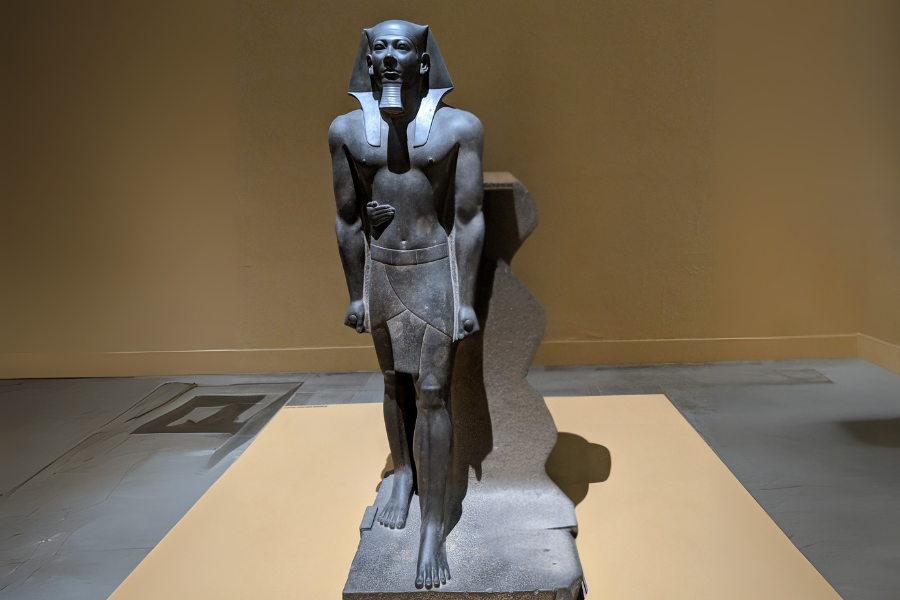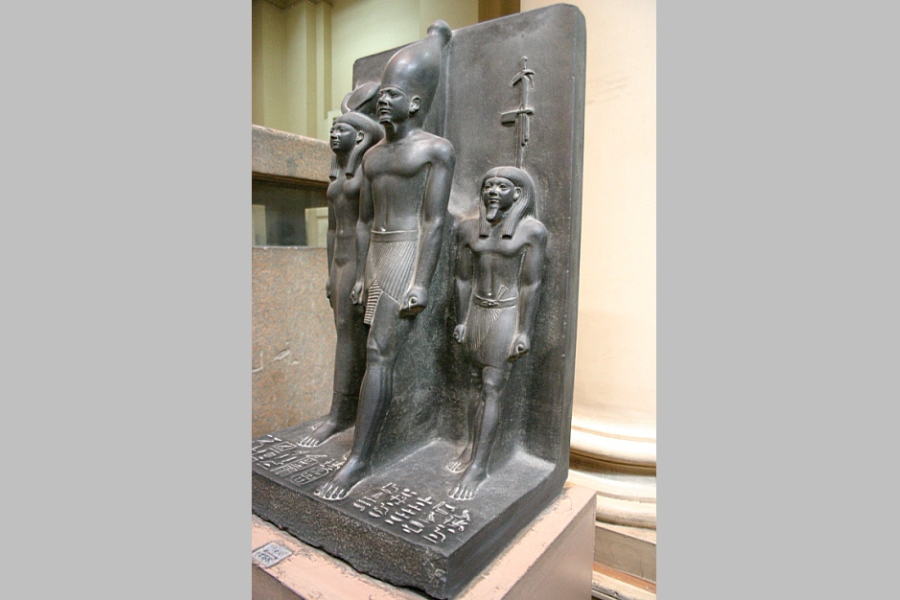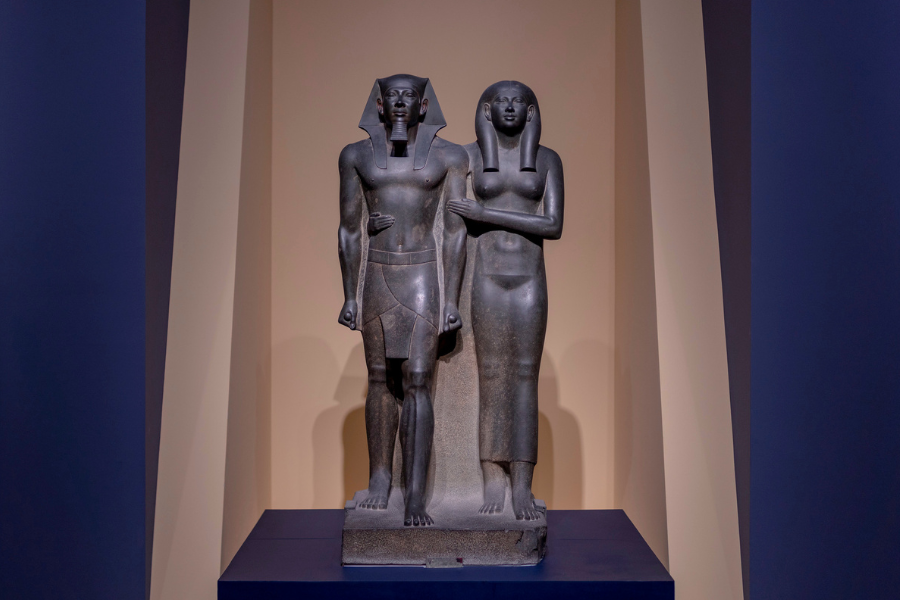King Menkaure of the Fourth Dynasty – Pyramid, Family & Statues
King Menkaure – Biography, Pyramid & Statue Triads
King Menkaure (also spelled Menkaura) was the Fifth King of Egypt’s 4th Dynasty and builder of the third Giza pyramid. Remembered as a just, approachable ruler, he left a legacy far beyond his smaller pyramid: elegant royal statues and iconic triads that capture the spirit of Old Kingdom art.
In this guide, explore Menkaure’s family and reign, the Pyramid of Menkaure with its striking granite casing, the famous triads of King Menkaure, and where to see them today—plus quick facts and FAQs for travelers and history fans.
Who Was King Menkaure?
King Menkaure—grandson of Khufu and son of Khafre—ruled in the late 4th Dynasty (Old Kingdom). Ancient tradition remembers him as a kind, well-loved monarch. He likely reigned for roughly a couple of decades and established his palace and funerary complex beside his pyramid on the Giza Plateau.
King Menkaure’s Family
Like many Old Kingdom royals, Menkaure belonged to an extended courtly network of kings, queens, and viziers. Highlights from the traditional king lists and archaeological finds:
- Father: Pharaoh Khafre; Grandfather: Khufu.
- Mother: Queen Khamerernebty I (attested by inscriptions found in his tomb context).
- Brothers: Nebemakhet, Nikaure, Iunmin, Sekhemkare (some served as viziers).
- Wives: Queen Khamerernebty II (likely his sister); Queen Rekhetre (half-sister).
- Children: Crown Prince Khuenre (died young); his brother Shepseskaf succeeded Menkaure; plus other sons/daughters recorded in later sources.
The Pyramid of Menkaure (Giza’s Third Pyramid)
In Egyptian, Menkaure pyramid was called Netjer-er-Menkaure—“Menkaure is Divine.” Its base measures about 108.5 m, and its original height was around 65.5 m, making it smaller than the pyramids of Khufu and Khafre—but no less compelling.
Look closely at the lower courses: they’re sheathed in red granite, a striking contrast to the pale limestone used higher up. The complex includes three subsidiary (queens’) pyramids; two were left unfinished for unknown reasons, while the most complete houses a Queen’s statue.
King Menkaure died before his pyramid complex was fully finished; his successor Shepseskaf completed key elements. Today, visitors can still sense the precision of its masonry and the power of its simplified geometry on the Giza plateau near Cairo.
King Menkaure Statue
King Menkaure statues are among the most refined examples of Old Kingdom royal art. Carved primarily from greywacke or schist, they emphasize strength, youthful vigor, and divine authority. His statues often depict him striding forward with his left leg, wearing the royal kilt, a false beard, and either the White or Red Crown of Egypt.
The facial features are distinctive: broad cheeks, almond-shaped eyes, a straight nose, and a calm, composed expression—symbols of eternal kingship. The musculature of the chest and limbs is rendered with striking detail, projecting power and perfection.
These statues not only decorated temples and tombs but also reinforced the king’s eternal presence and divine legitimacy. Today, Pharaoh Menkaure’s statues can be seen in the Egyptian Museum in Cairo, the Museum of Fine Arts in Boston, and other major collections worldwide, continuing to inspire awe in modern audiences.
Triads of King Menkaure
Five triad statues were discovered (greywacke/schist), showing King Menkaure flanked by Goddess Hathor and a local nome deity. Three triads are in the Egyptian Museum (Cairo); another and fragments are in the Museum of Fine Arts, Boston. Scholars suggest many more triads were intended—possibly one for each nome—to project royal presence across Egypt.
First Triad of Pharaoh Menkaure
Found in the Valley Temple at Giza, the triad depicts King Menkaure between Hathor and the local Egyptian goddess of the 17th Upper Egyptian nome (Inpw, meaning “City of the Jackal”). The king wears the White Crown and short shendyt kilt; the sculptor carved refined facial features and athletic anatomy. Hathor embraces the king in protective favor.
Second Triad of King Menkaure
Here Pharaoh Menkaure stands with Hathor and the goddess of the 8th Upper Egyptian nome (BAt, later called Diospolis by the Greeks). The grouping projects royal authority and local divine protection working in harmony.
Third Triad of Pharaoh Menkaure
This version pairs Pharaoh Menkaure and Hathor with the deity of the 4th Upper Egyptian nome (WAst), the region later known as Thebes. Inscriptions praise the king as “Horus, the strong bull,” beloved of Hathor.
Fourth & Fifth Triads of King Menkaure
Beyond the three well-preserved triads, archaeologists also uncovered a fourth triad statue and fragments of a fifth triad. These pieces are now displayed at the Museum of Fine Arts in Boston. Despite their incomplete state, they confirm that Pharaoh Menkaure commissioned multiple sets of triads, likely intended for shrines across Egypt.
Some Egyptologists suggest there may have originally been eight triads, while others argue for as many as thirty—symbolizing Egypt’s nomes. Each triad represented the king’s divine right to rule, flanked by Hathor and a local deity, affirming his presence in every province of Egypt.
Together, these triads demonstrate Menkaure’s political and religious strategy: blending royal power with local cults to strengthen unity across Upper and Lower Egypt.
King Menkaure and Queen
One of the most iconic statues from the Old Kingdom is the dyad of King Menkaure and a queen. This masterpiece, carved from greywacke, shows the king standing tall beside his queen, who gently embraces him with one arm. The gesture symbolizes unity, protection, and royal partnership.
Scholars debate the queen’s identity: she is most often identified as Queen Khamerernebty II, but some suggest she may represent another royal wife. Regardless, the dyad conveys an image of idealized beauty and timeless strength.
The statue reflects the artistic conventions of the Old Kingdom: Menkaure wears the royal shendyt kilt and nemes headdress, while the queen dons a long, form-fitting dress. Their calm, youthful faces emphasize eternity and divine perfection.
Today, this dyad remains one of the most studied and photographed Egyptian statues, displayed prominently in museum collections and textbooks as a symbol of pharaonic majesty and companionship.
Quick Facts about King Menkaure
- Names: Menkaure (also Menkaura)
- Dynasty: 4th Dynasty, Old Kingdom
- Pyramid: Giza’s third pyramid (Netjer-er-Menkaure), base ~108.5 m, height ~65.5 m
- Materials: Lower casing in red granite; upper courses in fine limestone
- Family: Son of Khafre; grandson of Khufu; succeeded by Shepseskaf
- Art: Triads with Hathor + nome deities (Cairo & Boston); famous dyad with a queen
Conclusion
Though smaller than the pyramids of Khufu and Khafre, the Pyramid of Menkaure pairs compact scale with exquisite detail. Through elegant statues and triads, King Menkaure—the humane ruler of Giza’s third pyramid—left an enduring artistic and architectural legacy that still captivates visitors today.
See Menkaure’s Pyramid & Art with Expert Egyptologists
Stand beside the granite casing of Menkaure’s pyramid and trace the artistry of his triads in world-class museums:
FAQ – King Menkaure
Which pyramid did King Menkaure build?
The third pyramid at Giza, known as the Pyramid of Menkaure (Netjer-er-Menkaure), recognizable by its lower courses of red granite.
How tall is the Pyramid of Menkaure?
Originally about 65.5 meters high with a base of roughly 108.5 meters.
What are the “triads” of Pharaoh Menkaure?
Statues showing Menkaure with Hathor and a nome deity. Several survive—three in Cairo and another with fragments in Boston—revealing superb Old Kingdom craftsmanship.
Is Menkaure also spelled differently?
Yes—Menkaura is a common alternate transliteration.













